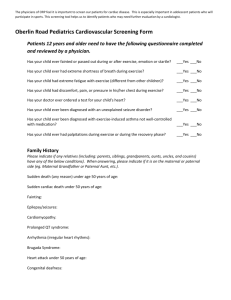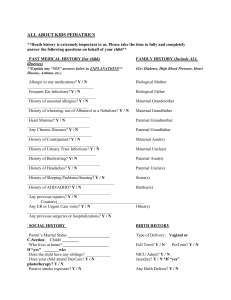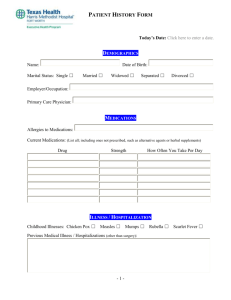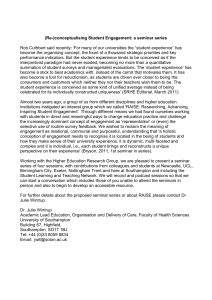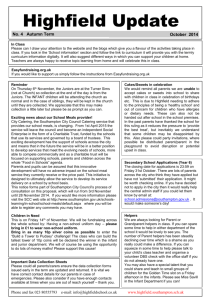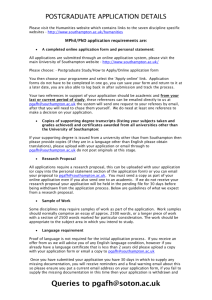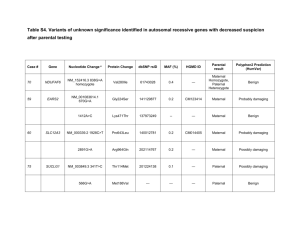srep04705-s1
advertisement
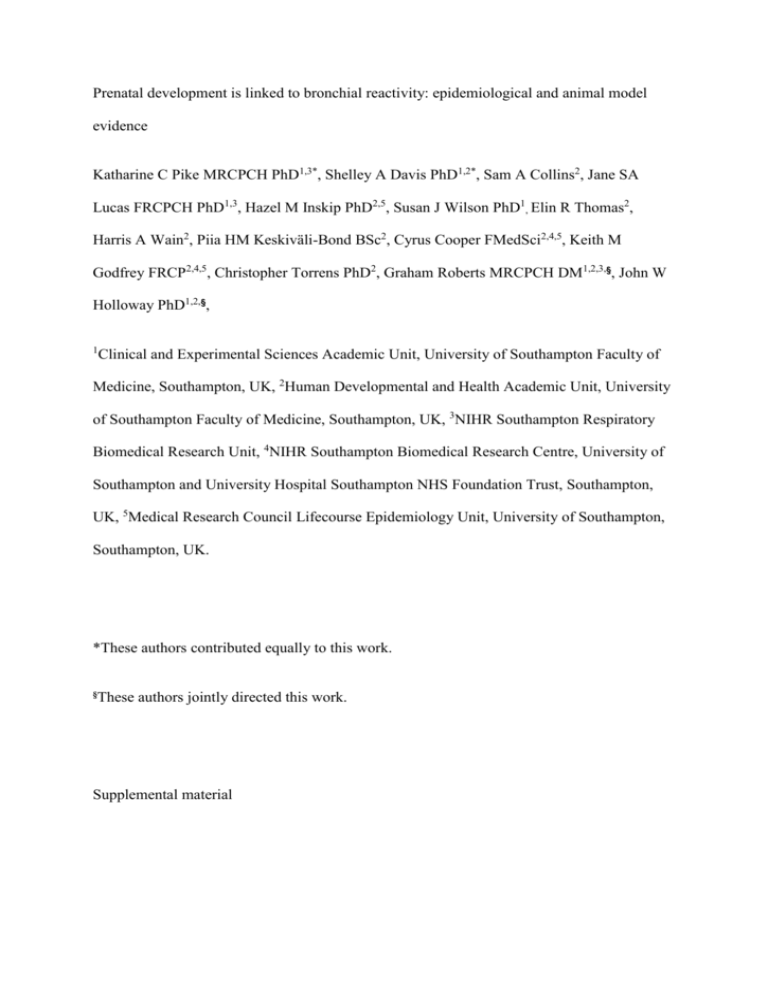
Prenatal development is linked to bronchial reactivity: epidemiological and animal model evidence Katharine C Pike MRCPCH PhD1,3*, Shelley A Davis PhD1,2*, Sam A Collins2, Jane SA Lucas FRCPCH PhD1,3, Hazel M Inskip PhD2,5, Susan J Wilson PhD1, Elin R Thomas2, Harris A Wain2, Piia HM Keskiväli-Bond BSc2, Cyrus Cooper FMedSci2,4,5, Keith M Godfrey FRCP2,4,5, Christopher Torrens PhD2, Graham Roberts MRCPCH DM1,2,3,§, John W Holloway PhD1,2,§, 1 Clinical and Experimental Sciences Academic Unit, University of Southampton Faculty of Medicine, Southampton, UK, 2Human Developmental and Health Academic Unit, University of Southampton Faculty of Medicine, Southampton, UK, 3NIHR Southampton Respiratory Biomedical Research Unit, 4NIHR Southampton Biomedical Research Centre, University of Southampton and University Hospital Southampton NHS Foundation Trust, Southampton, UK, 5Medical Research Council Lifecourse Epidemiology Unit, University of Southampton, Southampton, UK. *These authors contributed equally to this work. § These authors jointly directed this work. Supplemental material Methods Dietary protocol Virgin female Wistar rats (supplied by Harlan, UK) weighing approximately 200-250 g were mated with stud males. Conception was confirmed by the presence of a vaginal plug. Once pregnant, animals were fed either a control (C; 18 % casein) or a protein-restricted diet (PR; 9 % casein) through to delivery. The experimental diet constituents were as previously described by Itoh et al.1 Mother and pups were returned to standard laboratory chow postpartum. Pups were weighed 48 h after birth (to avoid rejection) and litters were culled to eight by cervical dislocation, with equal male and female offspring where possible. The offspring were weaned from their mothers at 21 days of age and then separated into male and female cages. At 35, 75 or 225 days of age male offspring were sacrificed by cervical dislocation and lung tissue was harvested. Assessment of bronchoconstriction Following post mortem lungs were excised and placed in ice cold (4 C) physiological salt solution (PSS) of the following composition; NaCl, 119; KCl, 4.7; CaCl2, 2.5; MgSO4, 1.17; NaHCO3, 25; KH2PO4, 1.18; EDTA, 0.026; and D-glucose, 5.5 mM. Segments of bronchi were dissected out, cleaned of surrounding tissue, cut into 2 mm segments and mounted on the wire myograph (Danish Myo Technology A/S, DK). Segments of bronchi were maintained in PSS heated to 37°C and continually gassed with 95% O2 and 5% CO2. The segments were stretched to an optimal resting tension equal to 1.5 g and allowed to equilibrate for 1 hour. Functional integrity was tested by the addition of 125 mM KPSS solution (PSS with an equimolar substitution of KCl for NaCl). Bronchoconstriction was assessed by the construction of cumulative concentrationresponse curves to the acetylcholine mimetic, carbachol (CCh, 1 nM-10 µM) and the thromboxane mimetic, U46619 (1pM-1µM). Morphometry Following post mortem left lungs were formalin fixed for 24 hours then embedded in Paraffin wax. 5µm thick sections were taken from a random starting point (first full block of paraffin cut that included tissue). Entire lung was cut, with 20 sections per layer and 100 sections removed between layers. One section per layer was H&E stained. Stereology was done using volume fractionation to estimate percentage components of the lung structure as previously described.2 Human Participants Participants were mother-child pairs participating in the Southampton Women’s Survey; details of follow-up within this study have been published previously.3 Briefly, during 1998 - 2002 women aged 20 - 34 years were recruited and those who became pregnant were followed through pregnancy and during their child’s infancy and childhood. Childhood follow-up visits were conducted at 6, 12, 24 and 36 months and those children aged between their sixth and seventh birthdays during 2006 - 2010 were invited for detailed respiratory follow-up during this period. 951 children attended the respiratory follow-up; of these 246 agreed to undergo a methacholine provocation challenge. Seven of the children who underwent methacholine challenge were born < 35 weeks’ gestation; data from these children were excluded to remove the effects of prematurity upon respiratory development. Parental consent was obtained and ethical approval was granted by the Southampton and South West Hampshire Local Research Ethics Committee (LREC Number 276/97, 307/97, 089/99 and 06/Q1702/104). Fetal growth Gestational age was determined from last menstrual period and early ultrasound data. Experienced research ultrasonographers used Acuson 128 XP, Aspen and Sequoia ultrasound machines calibrated to 1540 m/s to measure fetal head and abdominal circumferences at 11, 19 and 34 weeks gestation from standardized anatomical landmarks. Research nurses measured head and abdominal circumferences and weight at birth. The method of Royston was used to calculate conditional velocities of prenatal head and abdominal circumference growth, correcting for exact age at measurement and for regression to the mean.4 Bronchial hyperreactivity Bronchial hyperreactivity was measured by bronchial provocation challenge, according to ATS/ERS guidelines. Incremental methacholine concentrations (0.06 mg/ml to 16 mg/ml) were delivered using a dosimeter (Koko; PDS Instrumentation; Louisville, USA) and a compressed air driven nebulizer (Sidestream®; Respironics, UK).5 Challenges were terminated following a 20% fall in the FEV1 or, if this did not occur, following the 16 mg/ml dose. BHR was expressed as the inverse of the slope of the regression line through FEV1 drop and logged methacholine concentration such that lower inverse log slope values indicate increased BHR. Log slope=100/[regression slope of FEV1 drop and log10(cumulative methacholine dose) + 10] A constant removes negative values and an inverse transformation ensures the variable is normally distributed.6 Calculations and statistical analysis All animal data are expressed as mean ± (S.E.M). Constrictor responses are expressed as the change in raw tension (g). Cumulative CRCs to agonists were analysed by fitting to a four-parameter logistic equation using non-linear regression to obtain the pEC50 (effective concentration equal to 50% of maximum) and a maximal response, which were compared by Student’s t test (Prism 5.0, GraphPAD software Inc., San Diego, CA, U.S.A.). Significance was accepted if p<0.05. At all points the investigator was blinded to the dietary group. The relationships between fetal growth and the continuous BHR outcome was explored using linear regression. The following potential confounders were identified a priori: maternal history of asthma, eczema, rhinitis or atopy; paternal history of asthma, eczema or rhinitis; maternal age, body mass index, height, smoking in pregnancy, educational achievement and parity; child’s gender and parental social class. A multivariate model was built using a forward stepwise method to include all variables associated at the 0.1 level of significance or below. Measures of fetal size and growth velocity were standardized and outcomes were expressed in units of change in BHR per SD change in predictor. Stata® 11 (Stata Corp., College Station, TX) was used for all analyses. References: 1. Itoh H, Ohshima S, Shumiya S, Sakaguchi E. Development of a diet for long-term raising of f344 rats--relationship between dietary digestible crude protein content and digestible energy content. Experimental animals / Japanese Association for Laboratory Animal Science 2002;51:317-326. 2. Howard C & Reed M. Unbiased stereology: Three-dimentional measurment in microscopy. Oxford, United Kingdom: Bios Scientific Publishers; 1998. 3. Inskip HM, Godfrey KM, Robinson SM, Law CM, Barker DJ, Cooper C. Cohort profile: The southampton women's survey. Int J Epidemiol 2006;35:42-48. 4. Royston P, Altman DG. Design and analysis of longitudinal studies of fetal size. Ultrasound Obstet Gynecol 1995;6:307-312. 5. Crapo RO, Casaburi R, Coates AL, Enright PL, Hankinson JL, Irvin CG, MacIntyre NR, McKay RT, Wanger JS, Anderson SD, Cockcroft DW, Fish JE, Sterk PJ. Guidelines for methacholine and exercise challenge testing-1999. This official statement of the american thoracic society was adopted by the ats board of directors, july 1999. Am J Respir Crit Care Med 2000;161:309-329. 6. Chinn S, Arossa WA, Jarvis DL, Luczynska CM, Burney PG. Variation in nebulizer aerosol output and weight output from the mefar dosimeter: Implications for multicentre studies. Eur Respir J 1997;10:452-456. Table S1. Comparison of SWS mother-child pairs with 6 year follow-up data with those without but born within the same time period. Maternal characteristics Age at child’s birth (mean (SD)) Primiparous (n (%)) No Yes Education attainment None (n (%))* GCSE D-G GCSE A*-C A Level HND University degree Parents’ social class I (n (%))† II III Non-manual III Manual IV V Smoked in pregnancy (n (%)) No Yes Maternal asthma (n (%)) No Yes Maternal childhood eczema (n (%)) No Yes Maternal rhinitis (n (%)) No Yes Maternal atopy (n (%)) No Yes Pre-pregnancy BMI, kg/m2 (median, IQR) Height, cm (mean, SD) Paternal characteristics Paternal asthma (n (%)) No Yes Paternal childhood eczema (n (%)) No Yes Mother-child pairs in 6 year follow-up (n=925) Mother-child pairs where child aged 6 during followup but child not seen (n=570) Pvalue 30.24 (3.81) 29.76 (3.75) 0.017 486 (52.60) 438 (47.40) 14 (1.52) 88 (9.52) 268 (29.00) 269 (29.11) 67 (7.25) 218 (23.59) 97 (10.60) 452 (49.40) 253 (27.65) 72 (7.87) 39 (4.26) 2 (0.22) 349 (61.23) 221 (38.77) 35 (6.15) 64 (11.25) 161 (28.30) 170 (29.88) 39 (6.85) 100 (17.57) 49 (11.95) 177 (43.17) 108 (26.34) 50 (12.20) 19 (4.63) 7 (1.71) 0.001 771 (85.29) 133 (14.71) 428 (77.54) 124 (22.46 <0.001 720 (78.60) 196 (21.40) 429 (76.20) 134 (23.80) 0.281 749 (81.86) 166 (18.14) 462 (82.06) 101 (17.94) 0.922 529 (57.75) 387 (42.25) 342 (60.75) 221 (39.25) 0.256 431 (52.75) 386 (47.25) 24.32 (22.0427.53) 163.53 (6.59) 232 (57.43) 172 (42.57) 24.06 (21.8027.38) 162.73 (6.00) 0.123 752 (82.73) 157 (17.27) 440 (79.85) 111 (20.15) 0.169 792 (88.00) 108 (12.00) 487 (88.55) 63 (11.45) 0755 <0.001 0.028 0.570 0.020 Paternal rhinitis (n (%)) No Yes Child’s characteristics Gender (n (%)) Male Female Birth weight, kg (mean (SD)) 592 (65.70) 309 (34.30) 370 (67.03) 182 (32.97) 0.604 478 (51.68) 305 (53.70) 0.448 447 (48.32) 263 (46.30) 3480.60 3474.80 0.827 (496.14) (494.20) Gestational age, weeks (median (IQR)) 40.14 (39.1440.10 (39.140.995 41.00) 41.00) Length at birth, cm (mean (SD)) 49.93 (2.02) 49.79 (1.99) 0.183 Weight age six years, kg (median (IQR)) 22.30 (20.40Not measured 24.80) Height age six years, cm (mean (SD)) 119.18 (5.20) Not measured Age at testing years, (median (IQR)) 6.46 (6.34Not measured 6.61) Numbers do not always add to the full column totals due to missing data Binary outcomes were compared by χ2 test, categorical outcomes by a χ2 test for trend, and continuous variables using t-tests, after transformation where appropriate, or a rank sum test. * GCSE General certificate of secondary education, high school education (to age 16) graded from G (low) to A* (high), A level Advanced level high school education (to age 18), HND Higher national diploma higher education qualification of slightly lower level than that of a university degree. † Social class graded from V (low) to (I) high according to occupation Table S2. Comparison of SWS mother-child pairs with BHR data with those without but born in the same time period and thus eligible for 6 year follow-up. Maternal characteristics Age at child’s birth (mean (SD)) Primiparous (n (%)) No Yes Education attainment None * (n (%)) GCSE D-G GCSE A*-C A Level HND University degree Parents’ social class I (n (%))† II III Non-manual III Manual IV V Smoked in pregnancy (n (%)) No Yes Maternal asthma (n (%)) No Yes Maternal childhood eczema (n (%)) No Yes Maternal rhinitis (n (%)) No Yes Maternal atopy (n (%)) No Yes Pre-pregnancy BMI, kg/m2 (median, IQR) Height, cm (mean, SD) Paternal characteristics Paternal asthma (n (%)) No Yes Paternal childhood eczema (n (%)) No Yes Paternal rhinitis (n (%)) No Yes Mother-child pairs with BHR data (n=239) Mother-child pairs without BHR data (n=1256) Pvalue 30.51 (3.79) 29.97 (3.79) 0.04 151 (63.45) 87 (36.55) 5 (2.09) 30 (12.55) 74 (30.96) 74 (30.96) 11 (4.60) 45 (18.83) 20 (8.37) 114 (47.70) 65 (27.20) 25 (10.46) 14 (5.86) 1 (0.42) 684 (54.46) 572 (45.54) 44 (3.51) 122 (9.73) 355 (28.31) 365 (29.11) 95 (7.58) 273 (21.77) 126 (11.60) 515 (47.42) 296 (27.26) 97 (8.93) 44 (4.05) 8 (0.74) 0.010 198 (84.26) 37 (15.74) 1001 (81.98) 220 (18.02) 0.403 178 (74.79) 60 (25.21) 971 (78.24) 270 (21.26) 0.241 198 (83.19) 40 (16.81) 1013 (81.69) 227 (18.31) 0.582 135 (56.72) 103 (43.28) 736 (59.31) 505 (40.69) 0.458 116 (54.98) 95 (45.02) 24.73 (22.3927.57) 163.76 (6.56) 547 (54.16) 463 (45.84) 24.11 (21.8927.49) 163.12 (6.34) 0.828 199 (84.32) 37 (15.68) 993 (81.13) 231 (18.87) 0.246 212 (90.99) 21 (9.01) 1067 (87.67) 150 (12.33) 0.151 163 (69.96) 70 (30.04) 799 (65.49) 421 (34.51) 0.187 0.185 0.146 0.185 0.153 Child’s characteristics Gender (n (%)) Male Female Birth weight, kg (mean (SD)) 126 (52.72) 113 (47.28) 3493.85 (474.40) 40.00 (39.1440.86) 49.98 (2.04) 22.3 (20.424.9) 657 (52.39) 0.926 597 (47.61) 3475.47 0.601 (499.23) Gestational age, weeks (median (IQR)) 40.14 (39.140.260 41.00) Length at birth, cm (mean (SD)) 49.86 (2.00) 0.39 Weight age six years, kg (n (%)) Not measured in those not followed up Height age six , cm (n (%)) 121.16 (5.56) Not measured in those not followed up Age at testing years, (median (IQR)) 6.47 (6.35Not measured 6.65) in those not followed up Numbers do not always add to the full column totals due to missing data Binary outcomes were compared by χ2 test, categorical outcomes by a χ2 test for trend, and continuous variables using t-tests, after transformation where appropriate, or a rank sum test. * GCSE General certificate of secondary education, high school education (to age 16) graded from G (low) to A* (high), A level Advanced level high school education (to age 18), HND Higher national diploma higher education qualification of slightly lower level than that of a university degree. † Social class graded from V (low) to (I) high according to occupation Table S3. Primers and probes used for mRNA analysis Gene Sequence Forward Primer β-actin Rho A Reverse Primer 5’- CACAGCCTGGATGGCTACGT-3 Probe 5’-FAM- TTTGAGACCTTCAACACCCCAGCCAT -TAMRA-3’ Forward Primer 5’- -3’ Reverse Primer 5’- -3’ Probe ROCK1 5’-FAM- -TAMRA-3’ Forward Primer 5’- -3’ Reverse Primer 5’- -3’ Probe ROCK” 5’- CGTGAAAAGATGACCCAGATCA-3’ 5’-FAM- -TAMRA-3’ Forward Primer 5’- -3’, Reverse Primer 5’- -3’ Probe 5’-FAM- -TAMRA-3’ Figure S1: Cumulative addition of CCh to isolated bronchi from 75 day old male offspring from C (ο, n=8) or PR (•, n=8) dams in the absence (A) or presence (B) of the Rho kinase inhibitor Y27632 (10 M). . * indicates p<0.05 C vs. PR A B 250 250 * 200 % c o n s tric tio n % c o n s tric tio n 200 150 100 50 0 150 100 50 0 -9 -8 -7 -6 -5 lo g [C C h ] (M ) -4 -3 -9 -8 -7 -6 -5 lo g [C C h ] (M ) -4 -3
